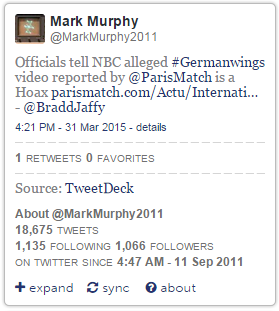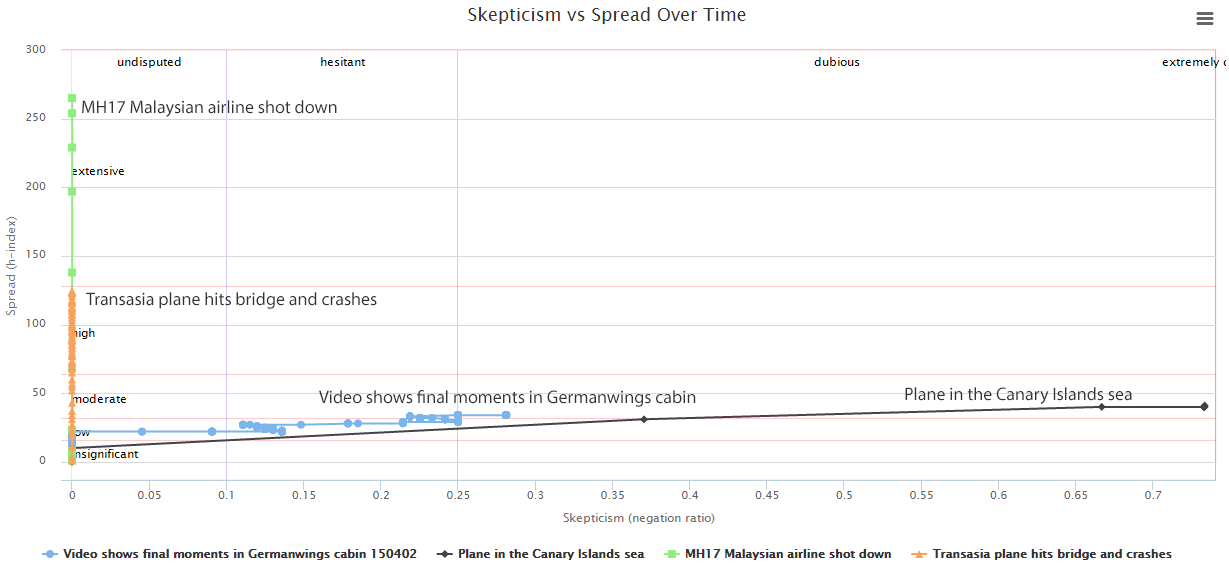On March 31, 2015, at around 1 PM eastern time (9 PM in Germany), German news outlet Bild posted an article claiming they had received a cell phone video of the final moments of the Germanwings flight, which was crashed by the co-pilot in the French Alps. Bild writes (in their English translation):
Paris – A video emerged from on-board Germanwings flight 4U9525. German newspaper BILD and French magazine „Paris Match“ were able to view it.
– Video shows last seconds of death flight 4U9525, BILD
Paris Match, the French magazine which also claimed to see the video, describes it (from their English translation):
Its origin – a cell phone – was clear. The scene was so chaotic that it was hard to identify people, but the sounds of the screaming passengers made it perfectly clear that they were aware of what was about to happen to them. One can hear cries of “My God” in several languages. Metallic banging can also be heard more than three times, perhaps of the pilot trying to open the cockpit door with a heavy object. Towards the end, after a heavy shake, stronger than the others, the screaming intensifies. Then nothing.
– EXCLUSIVE: THE FINAL MOMENTS BEFORE THE CRASH, Paris Match
Neither organization posted the video, but rather descriptions of what the video showed.
When @cnnbrk posted the story, it was retweeted over 500 times, and the conversation began to pick up steam on Twitter. However, not all Twitter users were convinced, even before reports began to spread that French officials were denying the existence of this video. Continue reading to learn about how TwitterTrails allows users to trace the increasing doubt about the Germanwings cell phone video.
The Time Series graph allows users to compare the activity of the denial of a claim to the activity of its support. Shown below, supporting tweets (those that do not express doubt) are charted in green, while tweets expressing doubt are in black.
One observation we have made with TwitterTrails (and plan to continue studying) is that claims with strong emotional resonance tend to gain strong and often immediate support. The desire to spread information without stopping to consider or research its origin or veracity seems to be strongest when the information trigger strong emotions such as anger, outrage, sadness or shock. We believe this is the case with this claim: an alleged video showing the final moments on board a plane where 150 people died is shocking and upsetting enough to capture people’s interest despite there being no proof of the video’s existence.
However, it took very little time for doubt about the story to form, likely due to the absence of the video in either report. It was about 3 hours after the claim was made that the video existed that it was reported that French officials denied the existence of the video (including from CBS news: http://www.cbsnews.com/news/french-officials-deny-reports-of-germanwings-flight-9525-final-seconds-video/).
From the graph you can see that both denial and support of the claim were fairly active; support more than denial (as we often find to be the case, again perhaps attributable to the emotional nature of the claim), but the denial is persistent and enduring.
However, this graph only shows us the activity. The metrics TwitterTrails uses to determine whether a claim is likely true or false are Spread and Skepticism. Both metrics rely on the h-index algorithm, measuring how many tweets there are with many retweets.
Another tool TwitterTrails offers is a graph to chart the behavior of Spread and Skepticism over time. This graph gives us insight into how this story develops over time.

The Spread is charted on the y-axis, and Skepticism on the x-axis. Each point represents the Spread and Skepticism at a point in time. The blue line shows the behavior of spread and Skepticism over time. In the course of about four hours, the Spread of the claim increases from 0 to 22 (about two thirds of the final Spread value, 34). Then over the next four hours, the Spread remains constant but the Skepticism increases significantly, going from being undisputed to hesitant. Note that the Spread remaining constant does not mean people are not talking about the story; rather, it reflects that the amount of attention being paid to the claim is holding steady. However, the attention being paid to the denial of the claim begins to increase.
Skepticism is measured as a ratio of the spread the denial versus the spread of the supporting claim. As the denial increases, the Skepticism increases, but increased spread for support of the claim will decrease Skepticism. This is what we see happening in the graph: as the story gains attention and the Spread increases, Skepticism stays at 0, because people are mostly retweeting supporting tweets. However, after the initial period, the Skepticism increases (seen in the three plateaus in the graph, where Spread increases only slightly if at all, but Skepticism increases dramatically). The more attention gained by the story, the more people start to doubt that it is true. And the more people doubt the claim, the less it spreads.
It is also worth comparing the Spread vs Skepticism over time in this story to a few other similar stories: The claim that a plane crashed in the Canary Islands Sea (false), the claim that Malaysian Airlines flight MH17 was shot down (true), and the claim that a Transasia plane hit a bridge and crashed (true).
The two false stories are in blue (the Germanwings video) and black (the Canary Islands crash), and the two true stories are in green (MH17 being shot down) and orange (Transasia plane crash). All four of these stories are about airplane tragedies, and likely to trigger similar emotional reactions from users who see them on Twitter. The two true stories both increase in Spread over time, but neither shows much of Skepticism. Both false stories show strong and steady increases in Skepticism, which halt increases in Spread.
Currently, many major news outlets still report that French officials deny that the cell phone video showing the final moments of the Germanwings flight is real, and no evidence that the video is genuine has surfaced.
View this story on TwitterTrails!


